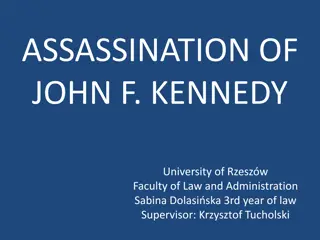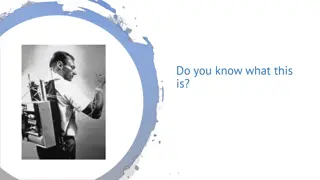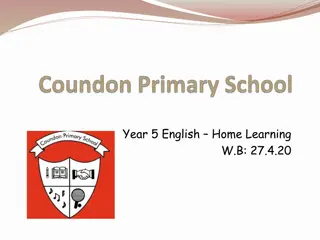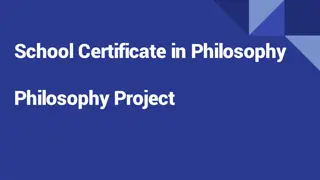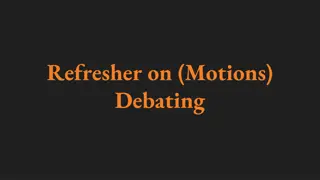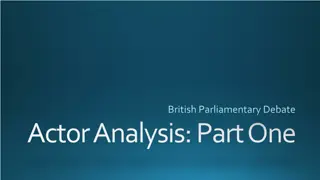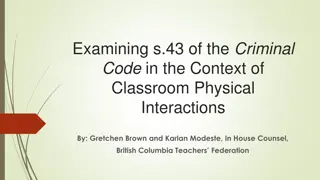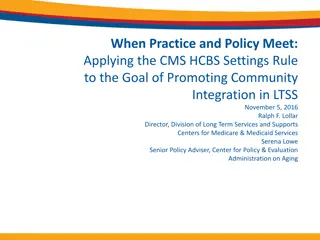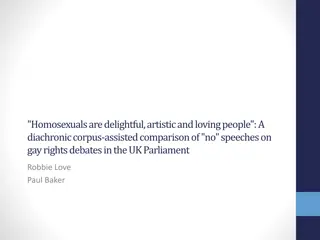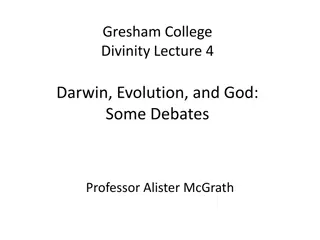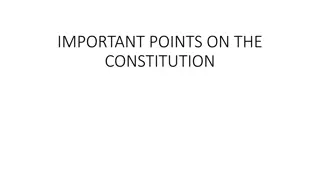Comprehensive Guide to Debates in Educational Settings
Understanding the key elements of debates including design, preparation, conducting, and post-debate discussions. Explore the structure, roles, and rules involved in debates to enhance critical thinking and communication skills among students.
Download Presentation

Please find below an Image/Link to download the presentation.
The content on the website is provided AS IS for your information and personal use only. It may not be sold, licensed, or shared on other websites without obtaining consent from the author.If you encounter any issues during the download, it is possible that the publisher has removed the file from their server.
You are allowed to download the files provided on this website for personal or commercial use, subject to the condition that they are used lawfully. All files are the property of their respective owners.
The content on the website is provided AS IS for your information and personal use only. It may not be sold, licensed, or shared on other websites without obtaining consent from the author.
E N D
Presentation Transcript
Debate Module 1/1 A.R.Renuka Devi AECS-3, Mumbai
Contents: What is debate? Design of debate Debate preparation Conducting debate Post-debate Discussion and Assessment Merits First steps Example
What is debate? Is a discussion or structured contest Is about an issue or a resolution. Involves two sides: one supporting a resolution and one opposing it. is bound by rules previously agreed upon. is judged in order to declare a winning side. is commonly used in democratic societies to explore and resolve issues and problems. In the context of a classroom, the topic for debate is guided by the knowledge, skill, and value outcomes as told in the curriculum.
Design for Debate Usually involves three groups: One supporting a resolution (affirmative team), One opposing the resolution (opposing team), audience those who are involved in judging. The affirmative and opposing teams usually consist of three members each. While the judging may be done by the teacher, a small group of students, or the class as a whole. In addition to the three specific groups, there may an audience made up of class members not involved in the formal debate. A specific resolution is developed and rules for the debate are established. (RUBRIC)
Debate Preparation: Develop the resolution to be debated. Organize the teams. Establish the rules of the debate, including timelines. Research the topic and prepare logical arguments. Gather supporting evidence and examples for position taken. Anticipate counter arguments and prepare rebuttals. Team members plan order and content of speaking in debate. Prepare room for debate. Establish expectations, if any, for assessment of debate.
Conducting Debate: Debate opens with the affirmative team (the team that supports the resolution) presenting their arguments, Followed by a member of the opposing team. This pattern is repeated for the second speaker in each team. Finally, each team gets an opportunity for rebutting the arguments of the opponent. Speakers should speak slowly and clearly. The judges and members of the audience should be taking notes as the debate proceeds. A typical sequence for debate, with suggested timelines, is as follows: The first speaker on the affirmative team presents arguments in support of the resolution. (5 10 minutes) .
Conducting Debate continued The first speaker on the opposing team presents arguments opposing the resolution. (5 10 minutes) The second speaker on the affirmative team presents further arguments in support of the resolution, identifies areas of conflict, and answers questions that may have been raised by the opposition speaker. (5 10 minutes) The second speaker on the opposing team presents further arguments against the resolution, identifies further areas of conflict, and answers questions that may have been raised by the previous affirmative speaker. (5 10 minutes) The rules may include a short recess for teams to prepare their rebuttals. (5 minutes) The opposing team begins with the rebuttal, attempting to defend the opposing arguments and to defeat the supporting arguments without adding any new information. (3 5 minutes) First rebuttal of the affirmative team (3 5 minutes) Each team gets a second rebuttal for closing statements with the affirmative team having the last opportunity to speak. (3 5 minutes each) There cannot be any interruptions. Speakers must wait their turns. The teacher may need to enforce the rules
Post-debate Discussion and Assessment When the formal debate is finished, allow time for debriefing and discussion. Members of the audience should be given an opportunity to ask questions and to contribute their own thoughts and opinions on the arguments presented Members of the debate teams may also wish to reflect on their performance and seek feedback from the audience, including the teacher. If some form of assessment was part of the debate plan, it would be conducted at this time. Assessment could be conducted by the teacher, the judging team, or the entire class.
Merits Meaningful listening, speaking, and writing practice Encourages analytic thinking Develops fluency High interest very motivating
First steps.. This is the best ..because (For---- contestants) This is the worst because ( Against ------ contestants ) 1. Each student picks an object . 2. Allow 5 minutes for listing positive and negative attributes. 3. Students take turns making minute-long speeches for or against object.
Examples: This is the best pen! It s blue and thick. I really like writing with it! It writes really smoothly, and everyone can read my writing when I write with it. Everyone likes getting notes from me when I write with this pen. Etc. etc.
Getting the idea Yes, and Yes, but 1. 2. 3. Choose a topic One student makes a statement The next student chooses to agree or disagree. To agree Yes, and (add a reason) To disagree Yes, but (add an opposing point)
Example: A: It s really important to brush your teeth every morning. B: Yes, and when you brush your teeth, your mouth smells good. C: Yes, but sometimes the toothpaste tastes terrible. D: Yes, but you can find a brand that tastes good. E: Yes, and even if it doesn t taste good, you spit it out after a minute!
I couldnt disagree more! Students can prepare or improvise Choose a topic serious or silly Examples: Smoking should be banned in public Love is more important than money Free lunches should be provided at school
First student presents one point Second student says I couldn t disagree more, and gives an opposing point Each student who speaks begins with the same phrase and presents a point opposing the previous speaker Allow as many students as possible to have a turn
Example A: We should all definitely be given free lunches at school every day. We can t be expected to study when we are hungry. B: I couldn t disagree more! We ll all get fat and feel sleepy if we eat a school lunch every day. C: I couldn t disagree more! The lunch would probably taste terrible, so we d only eat enough to stop feeling hungry and we wouldn t get fat.
Ping-Pong Debate Choose a topic Divide class in half and assign pro to one half and con to the other Give students a few minutes to write points for their side (individually) Choose the first speaker from the pro side. The debate goes back and forth between the sides, each student speaking once.
In Class Teams Debate Divide the class into teams of 3-4 students Assign each team a position pro or con Allow at least 20 minutes for teams to prepare for debate
Each team prepares 2 main points to support their position. For each point there should be a few examples and/or anecdotes. Arrange tables for teams around perimeter of the classroom.
Procedure One minute speeches alternate pro and con for first argument and then second argument Short break to prepare rebuttal speeches Alternate pro and con rebuttal speeches
Two teams debate Two teams of 3-4 students on opposing teams Students prepare position speeches by reading articles, discussing the issue, brainstorming Time for speeches is pre-determined longer as the students have more practice. Each speaker relates to the comments of the opposing previous speaker before presenting his/her point Final speaker on each side sums up points made and refutes points made by opposing team
Summing it Up Proceed gradually in small steps Students get used to making a logical point and listening to and refuting an opposing point Encourages civilized, thoughtful discussion Greatly increases fluency in English and students self- confidence in their ability to speak.


